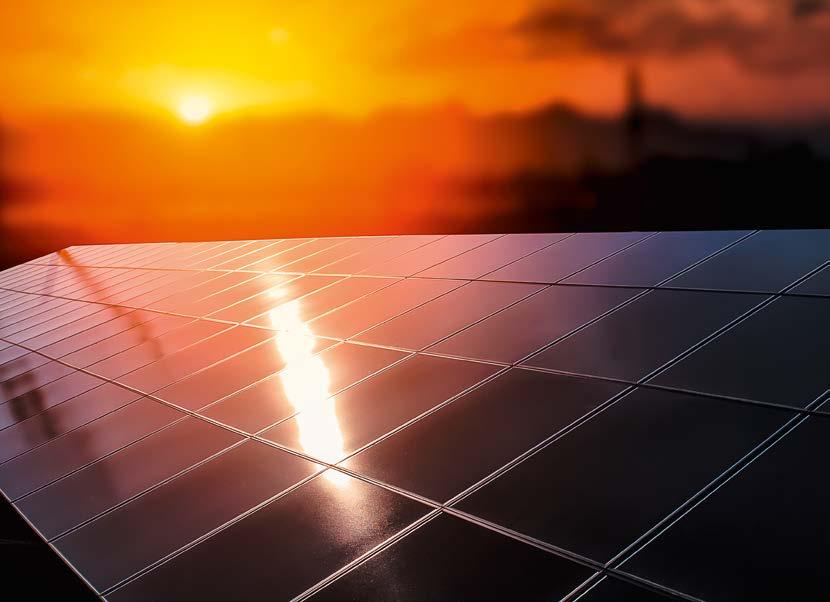
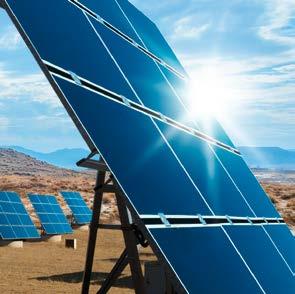



DEVELOPER, ENABLER & EQUIPMENT SUPPLIER FOR CIS/CIGS & CDTE SOLAR MODULES
In thin-film solar technology a large glass panel forms the base material, on which a relatively thin layer of 1 to 2 μm of photoactive compound is applied. Amongst others, alloys consisting of copper, indium, gallium and selenium or sulfur (CIGS), compounds of cadmium and tellurium (CdTe) or thin silicon layers are used in this process.
Due to a superior performance under low light intensities thin-film solar cells deliver electrical power already in the early morning and later evening hours or at clouded sky. In addition the panels are more tolerant against local

shadowing. Also, thin-film solar cells do not suffer so much in their performance at high solar panel temperatures occurring at full sun intensities. Furthermore, thin-film solar panels can be used as an architectural design element for the frontside or the roof of buildings due to their homogenous surface color and attractive visual appearance.
With our production equipment SINGULUS TECHNOLOGIES is one of the few companies able to equip both efficiently running factories for the manufacturing of CIS/CIGS and CdTe thin-film modules as well as single production equipment for the different manufacturing steps.
For the mass production of CIS/CIGS & CdTe
solar modules SINGULUS TECHNOLOGIES has introduced and delivered new machines for all relevant manufacturing steps:
» Sputtering
» Evaporation
» RTP for selenization & sulphurization
» CSS – Closed Space Sublimation
» Buffer layer deposition
» Wet-chemical cleaning
» Utilities
SINGULUS TECHNOLOGIES offers to its customers:
» Manufacturing equipment built to highest international standard
» Process know-how and process licenses with partners to provide a stable process
» Highest yield and efficiency
» Education and staff training for engineers and operators
» Ramp-up support
» Worldwide after-sales service
» Future upgrade packages
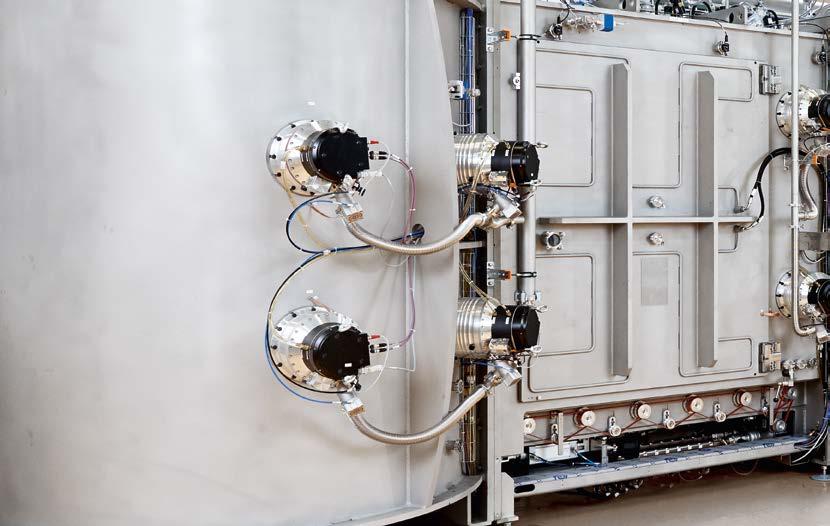
SINGULUS TECHNOLOGIES offers proven sputtering systems with vertical substrate transport with the brand name VISTARIS PVD. One major application is today’s CIGS & CdTe thin-film solar cell production. These systems have been developed to enhance the efficiency of thin-film solar cells, while cutting production costs by using the state-of-the-art technologies. For photovoltaic technology, SINGULUS TECHNOLOGIES develops and manufactures coating systems which can apply special layers and layer systems on different substrates. In addition to applications in the solar sector, this system also offers ideal conditions for other applications such as large glass surfaces. Examples are transparent front or metallic back contact layers as well as multilayered precursors with a broad range of different materials.
The VISTARIS PVD system is designed for sputtering materials like ITO, AZO and metallic layers like Mo, Al, Cu, Ag, NiV. The main advantage of the system is the use for vertical vacuum-based coating on glass substrates in various industries.

» Vertical large area PVD sputter systems are used for particle free process requirements


» Carrier usage for transport of the substrates
» Largest system built: 1,4 m x 1,6 m, possible up to 3,2 m x 4 m
» Tact time: up to 45 s per carrier
» Usage of rotatable cylindrical magnetrons for highest utilization of target material
» Temperature processing before and during deposition available
» DC; pDC; BP and RF process available
» Sputtering material: ITO, AZO and metallic layers like Mo, Al, Cu, Ag, NiV, etc.
» Vacuum base pressure: < 1 x 10-6 mbar
» Typical process pressure: 2 - 8 x10-3 mbar
» No carrier return system necessary
» Temperature range for deposition: up to 200 °C

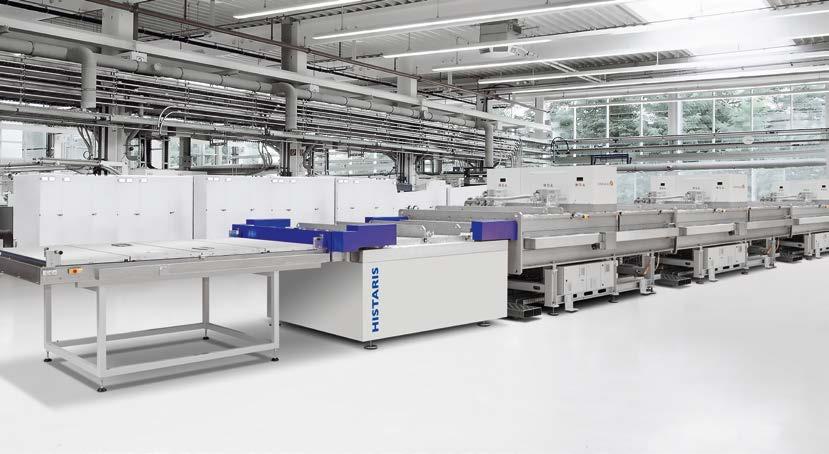
The HISTARIS PVD system was developed for the requirements in the photovoltaic industry but also for applications in large area sputtering like architectural glazing, fuel cells and mobile devices. The HISTARIS PVD system was designed to enhance the efficiency and cutting production costs by using the state-of-the-art technologies. The modular design includes process chambers equipped with rotatable magnetrons for the sputter deposition of high-performance TCO layers or several other materials, such as metals and metal oxides. Pre-treating modules for cleaning or etching can be added. With its unique modular design, the HISTARIS PVD system is ideally suited for challenging layer stacks and flexible product mixes.
Examples are transparent front or metallic back contact layers as well as multilayered precursors with a broad range of different materials. The main advantage of the system is that it can be used for horizontal vacuum-based coating of glass substrates in solar, display and many other industries. Typical applications include anti-reflection layers, barrier layers and precursor layers but also different metallic layers such as Al, Cu, NiV, etc.
The HISTARIS PVD is using an inline process in which the substrates are transported on specially designed carriers or directly on a customized roller drive system. Different automation options for loading and unloading are available.

» Sputtering material: ITO, AZO and metallic layers like Mo, Al, Cu, Ag, NiV etc.
» Parallel processing of several substrates
» Available in multiple versions, e.g.
Ű HISTARIS PVD LAB
Ű HISTARIS PVD Standard
Ű HISTARIS PVD Speed
» Modular configuration
» Low cost of ownership and high uptime
» Top down and bottom-up sputtering configurable
» Sputter sequence configurable
» DC; pDC; BP and RF process available
» Rotatable cylindrical magnetrons for highest utilization of target material
» Single end and double end version selectable
» Manual or semi-automated lab versions
» Tact time: up to 20 s per batch (without carrier)
» Usage of rotatable cylindrical magnetron for highest utilization of target material
» Highest deposition rates
» Temperature processing during deposition available
» Gas separation by dynamic slit valves and/or by individual lock chambers
» Vacuum base pressure: ‹ 1 x 10-6 mbar, typical process pressure: 2 - 5 x10-3 mbar
THE MODULARITY OF THE HISTARIS PVD SYSTEM ALLOWS A HIGH DEGREE OF FLEXIBILITY
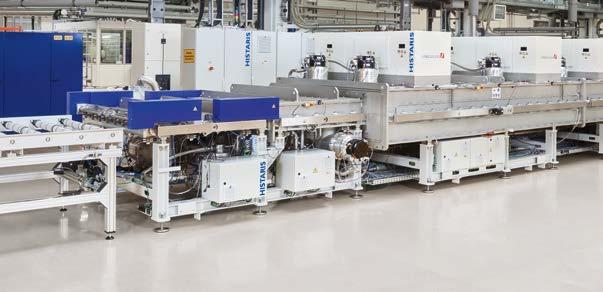
The inline evaporation tool SELENIUS is based on the thermal evaporation of CIGS-related precursor materials. It is dedicated to the deposition of copper-indium-gallium-selenium layers for the purpose to form optimum precursor layers in the application of CIGS thin-film solar modules. The modular chamber design allows a flexible layout to meet the production requests of the different customers. The SELENIUS system consists of a handling station, multiple substrate heating/cooling stations and deposition chambers.
The inline evaporation system is offering proven thermal deposition technology, that delivers a high material utilization and excellent layer uniformities. In combination with a high uptime and yield, the system leads to a highly optimized and flexible production platform. SINGULUS TECHNOLOGIES has delivered several systems to international thin-film solar manufacturers around the world.
» Inline evaporation tool with high throughput capability

» Optimized utilization of evaporation material through unique chamber design
» Horizontal substrate transport
» High deposition rate and repeatability
» Excellent flux uniformity
» Excellent temperature uniformity during process sequence
» Substrate pre-heating
» In-situ monitoring of flux and temperature
» Proven safety concept based on solid risk management and safety engineering
» Easy and fast source refilling/replacement due to user friendly source positioning
» Optimized maintenance concept
» Maximum machine availability/uptime

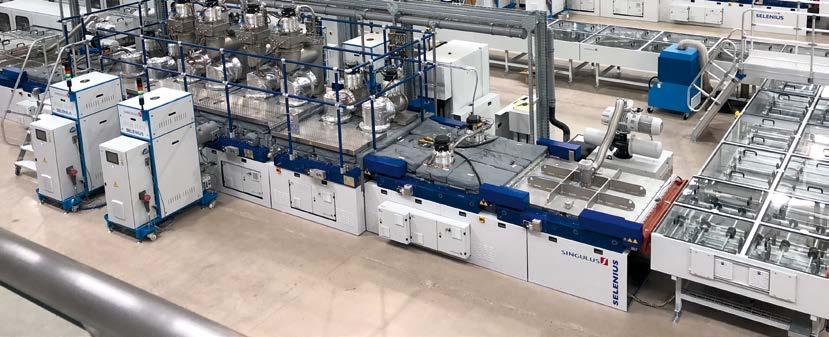
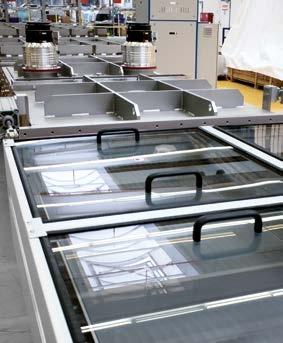
Rapid thermal processing (RTP) and Close Spaced Sublimation (CSS) are important process steps for the production of CIGS & CdTe solar modules. During CIGS Production the metallic precursors are selenized under high Se pressure by RTP method.
The Close Spaced Sublimation (CSS) is an important process step for the production of CdTe solar modules.
The CISARIS X3 oven is a new inline rapid thermal processing system designed for the CIGSSe absorber formation on large area glass substrates. CISARIS consists of a handling station, a vacuum tight process section, a return conveyor and is optimized for the mass production of CIGS solar modules.
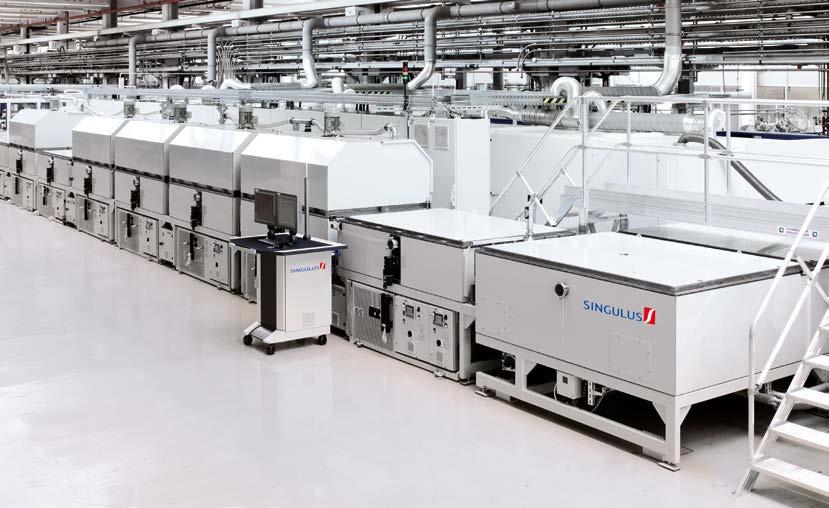
The main features of the CISARIS include a high uptime and mechanical yield, as well as a fast cycle time which, in combination with the robust selenization process, leads to a production capacity of over 75 MWp per year (depending on configuration). CISARIS is a proven innovative and reliable production tool, which has been developed at SINGULUS TECHNOLOGIES based on the previous generation of selenization ovens.
FEATURES
» Third generation inline selenization furnace with optimized cycle time
» Rapid heating (up to ~ 4 °C/s) of large glass substrates
» Uniform heating of large substrates up to 600 °C
» Uniform cooling of substrates to avoid glass warpage
» Excellent temperature control (mean variation < 5 °C)
The Close Spaced Sublimation (CSS) is one important process step for the production of CdTe solar modules. The CSS oven is installed in the flow of the manufacturing process as part of an automated fabrication line for the production of CdTe thin-film solar modules.
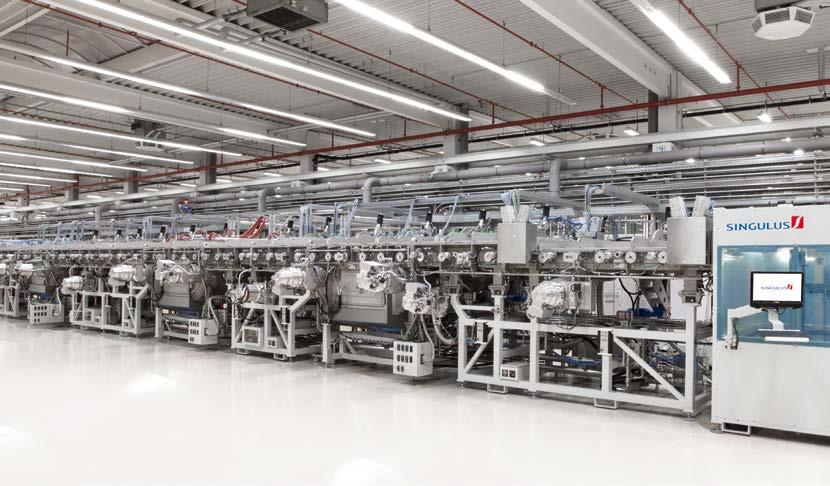
The sublimation step is used for the deposition of the active, light absorbing layers on the glass substrates. The CSS oven provides the deposition of the CdS or CdSe layer onto the TCO-coated side of a glass substrate as well as the CdTe layer on top of said CdS or CdSe film.
» Entrance module with interface to the fab automation
» Vacuum heating and cooling sections to establish a precise temperature profile into the substrates
» Deposition section with maintenance friendly sublimation sources
» Exit module for high homogeneous cool-down process
» Atmospheric cooling section with fast cooling function including interface to the fab automation
» Reliable vacuum systems
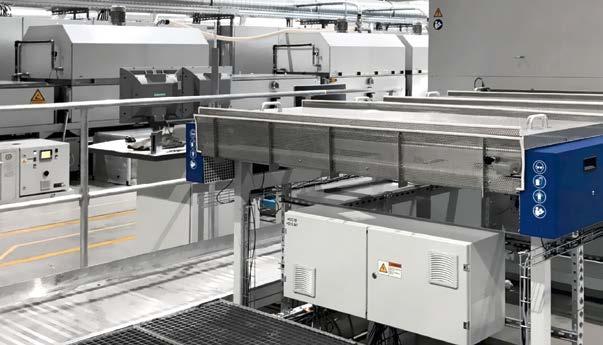
Your direct contact: www.singulus.com
Headquarters
SINGULUS TECHNOLOGIES AG
Hanauer Landstrasse 103
63796 Kahl, Germany
Tel. +49 6188 440-0
Fax +49 6188 440-1130 sales@singulus.de
Subsidiaries
China
SINGULUS TECHNOLOGIES
(SHANGHAI) Co. Ltd.
Room B412-413
No. 1400 Jiangchang Road
Jingan District, Shanghai Zip Code: 200072
Tel. +86 21 61073997 sales@singulus.cn
SINGULUS TECHNOLOGIES
Guangzhou Office
Room 539, 5F Block B
Nanlong Commercial Center
Dalong No.31 Shilian Road, Panyu
Guangzhou 511450
Tel. +86 13822138376 sales@singulus.cn
France
SINGULUS TECHNOLOGIES
FRANCE S.A.R.L.
Tel. +33 3 8931 1129 laurent.ferrer@singulus.fr
North America
SINGULUS TECHNOLOGIES INC.
Tel. +1 860 683 8000 sales@singulus.com
South America
SINGULUS TECHNOLOGIES
LATIN AMERICA LTDA.
Tel. +55 1121 6524-10 sales@singulus.com.br
Southeast Asia
SINGULUS TECHNOLOGIES
ASIA PACIFIC PTE LTD.
Tel. +65 67411912 sales@singulus.com.sg
Taipei Office
SINGULUS TECHNOLOGIES
TAIWAN LTD.
Tel. +886 2 8692 6996 sales@singulus.com.tw
SINGULUS TECHNOLOGIES develops and assembles innovative machines and systems for efficient thin-film coating and surface treatment processes, which are used worldwide in the Photovoltaics, Semiconductor, Medical Technology, Packaging, Glass & Automotive as well as Battery & Hydrogen markets.

The company’s core competencies include various processes of coating technology, surface treatment as well as wet-chemical and thermal production processes. SINGULUS TECHNOLOGIES sees sustainability as an opportunity to position itself with innovative products. In the focus are:
» Environmental awareness
» Efficient use of resources
» Avoidance of unnecessary CO₂ pollution
SINGULUS TECHNOLOGIES attaches great importance to responsible and sustainable corporate governance.